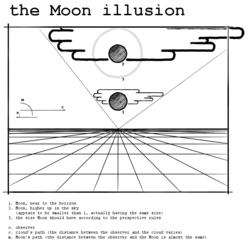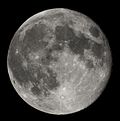- Moon illusion
-
The Moon illusion is an optical illusion in which the Moon appears larger near the horizon than it does while higher up in the sky. This optical illusion also occurs with the sun and star constellations. It has been known since ancient times, and recorded by numerous different cultures. The explanation of this illusion is still debated.[1]
Contents
Proof of illusion
A popular belief, stretching back at least to Aristotle in the 4th century B.C., holds that the Moon appears larger near the horizon due to a real magnification effect caused by the Earth's atmosphere. This is not true: although the atmosphere does change the perceived color of the Moon, it does not magnify or enlarge it.[2] In fact, the Moon appears about 1.5% smaller when it is near the horizon than when it is high in the sky, because it is farther away from the observer by up to one Earth radius and also because of atmospheric refraction, which makes the image of the Moon slightly smaller in the vertical axis. (Note that between different full moons, the Moon's angular diameter can vary from 33.5 arc minutes at perigee to 29.43 arc minutes at apogee—a difference of over 10%.[3] This is because of the ellipticity of the Moon's orbit.)
The angle that the full Moon subtends at an observer's eye can be measured directly with a theodolite to show that it remains constant as the Moon rises or sinks in the sky (discounting the very small variations due to the physical effects mentioned). Photographs of the Moon at different elevations also show that its size remains the same.[citation needed]
A simple way of demonstrating that the effect is an illusion is to hold a small object (say, 1/4 inch wide) at arm's length (25 inches) with one eye closed, positioning it next to the seemingly large Moon. When the Moon is higher in the sky, positioning the same object near the Moon reveals that there is no change in size.
Possible explanations
In the Book of Optics (1011-1022 C.E.), Ibn al-Haytham argued that vision occurs in the brain, and that personal experience has an effect on what people see and how they see, and that vision and perception are subjective. Arguing against Ptolemy's refraction theory, he redefined the problem in terms of perceived, rather than real, enlargement. He said that judging the distance of an object depends on there being an uninterrupted sequence of intervening bodies between the object and the observer. With the Moon, however, there are no intervening objects. Therefore, since the size of an object depends on its observed distance, which is in this case inaccurate, the Moon appears larger on the horizon. Through works by Roger Bacon, John Pecham and Witelo based on Ibn al-Haytham's explanation, the Moon illusion gradually came to be accepted as a psychological phenomenon, with Ptolemy's theory being rejected in the 17th century.[4]
For over 100 years, research on the Moon illusion has been conducted by vision scientists who invariably have been psychologists specializing in human perception. After reviewing the many different explanations in their 2002 book The Mystery of the Moon Illusion, Ross and Plug conclude "No single theory has emerged victorious".[5] The same conclusion is reached in the 1989 book, The Moon Illusion edited by Hershenson, which offers about 24 chapters written by different illusion researchers.
Angular size and physical size
The "size" of an object in our view can be measured either as angular size (the angle that it subtends [is in opposition to] at the eye, corresponding to the proportion of the field of vision that it occupies) or physical size (its real size measured in, say, metres). As far as human perception is concerned, these two concepts are quite distinct. For example, if two small, identical, and familiar objects are placed at distances of five and ten metres respectively, then the more distant object subtends approximately half the angle of the nearer object, but we do not normally perceive that it is half the size. Conversely, if the more distant object did subtend the same angle as the nearer object then we would normally perceive it to be twice as big.
A central question pertaining to the Moon illusion, therefore, is whether the horizon moon appears larger because its perceived angular size seems greater, or because its perceived physical size seems greater, or some combination of both. There is currently no firm consensus on this point.
Apparent distance hypothesis
An apparent distance theory evidently was first clearly described by Cleomedes around AD 200. The theory proposes that the horizon moon looks larger than the zenith moon because it looks farther away.
 Comparison between the size of the Moon and the size of a cloud as they move higher in the sky.[clarification needed]
Comparison between the size of the Moon and the size of a cloud as they move higher in the sky.[clarification needed]
When we see objects such as clouds, birds and airplanes in the sky, those near the horizon are typically further away from us than those overhead. This may result in the perception of the sky itself as a comparatively flat or only gently curving surface in which objects moving towards the horizon always recede away from us.
If we perceive the Moon to be in the general vicinity of those other things we see in the sky, we would expect it to also recede as it approaches the horizon, which should result in a smaller retinal image. But since its retinal image is approximately the same size whether it is near the horizon or not, our brains, attempting to compensate for perspective, assume that a low moon must be physically larger.
Extensive experiments in 1962 by Kaufman and Rock showed that a crucial causative factor in the illusion is a change in the pattern of cues to distance. (See Ponzo illusion, Depth perception, linear perspective, Texture gradient.) The horizon moon is perceived to be at the end of a stretch of terrain receding into the distance, accompanied by distant trees, buildings and so forth, all of which indicate that it must be a long way away, while these cues are absent from the zenith moon. Experiments by many other researchers have found the same result; namely, when pictorial cues to a great distance are subtracted from the vista of the large-looking horizon moon it looks smaller. When pictorial cues to an increased distance are added into the vista of the zenith moon, it appears larger.
A potential problem for the apparent distance theory has been that very few people (perhaps about 5%) perceive the horizon moon as being both larger and farther away. Indeed most people (perhaps 90%) say the horizon moon looks both larger and closer than the zenith moon (Boring, 1962, Hershenson, 1982, McCready, 1965, 1986, Restle, 1970). Most of the rest say it looks larger and about the same distance away as the zenith moon, with a few people reporting no Moon illusion at all. Nevertheless, the apparent distance explanation is the one most often found in textbooks.
Those advocating the apparent distance hypothesis might counter that in the Ponzo illusion, people do not perceive one line to actually be farther away than another either, or that everything on the horizon is perceived as further away, out of the habit that this is true for every object ever seen there (average-altitude clouds are about 100 times further away at the horizon than when overhead).
Relative size hypothesis
Historically, the best-known alternative to the "apparent distance" theory has been a "relative size" theory. This states that the perceived size of an object depends not only on its retinal size, but also on the size of objects in its immediate visual environment. In the case of the Moon illusion, objects in the vicinity of the horizon moon (that is, objects on or near the horizon) exhibit a fine detail that makes the Moon appear larger, while the zenith moon is surrounded by large expanses of empty sky that make it appear smaller.[6]
The effect is illustrated by the classic Ebbinghaus illusion shown at the right. The lower central circle surrounded by small circles might represent the horizon moon accompanied by objects of smaller visual extent, while the upper central circle represents the zenith moon surrounded by expanses of sky of larger visual extent. Although both central circles are actually the same size, to many people the lower one looks larger.
Angle of regard hypothesis
According to the angle of regard hypothesis, the Moon illusion is produced by changes in the position of the eyes in the head accompanying changes in the angle of elevation of the moon. Though once popular, this explanation no longer has much support.[4]
Historical References to the Moon Illusion
Immanuel Kant refers to the moon illusion in his 1781 text the Critique of Pure Reason when he writes that "the astronomer cannot prevent himself from seeing the moon larger at its rising than some time afterwards, although he is not deceived by this illusion."[7]
References
- ^ The Moon illusion Editor Maurice Hershenson Routledge, 1989 ISBN 0805801219, 9780805801217
- ^ "See a huge moon illusion". USA Today. 17 June 2008. http://www.usatoday.com/tech/science/space/2008-06-17-moon-illusion_N.htm.
- ^ Astronomy Picture of the Day — large and small full moons, NASA
- ^ a b Hershenson, Maurice (1989). The Moon illusion. http://books.google.co.uk/books?id=x1qcL4CTwlIC.
- ^ Helen Ross, Cornelis Plug (2002). The Mystery of The Moon Illusion. Oxford University Press, USA. Page 180.
- ^ Restle, Frank. (1970, February). "Moon Illusion Explained on the Basis of Relative Size", Science
- ^ Kant, Immanuel. Critique of Pure Reason. Trans. J.M.D. Meiklejohn. New York: Dover Publications, 1900. p. 189.
External links
- A vision scientist reviews and critiques moon illusion theories (and argues for oculomotor micropsia).
- Another careful review of moon illusion research.
- A physicist offers opinions about current theories
- Summer Moon Illusion - NASA
- Why does the moon look so big now?
- Why does the Moon appear bigger near the horizon? (from The Straight Dope)
- #moonillusion Moon illusion illustrated
- Moon illusion discussed at Bad Astronomy website
- New Thoughts on Understanding the Moon Illusion
- Father-Son Scientists Confirm Why Horizon Moon Appears Larger
- Astronomy Picture of the Day — 16 June 2009
The Moon Physical features 
Orbit Lunar surface - Selenography
- Near side
- Far side
- Lunar mare
- (List)
- Craters
- (List)
- Mountains
- Valleys
- South Pole – Aitken basin
- Shackleton crater
- Water
- Soil
- Peak of eternal light
- Space weathering
- Transient lunar phenomenon
Lunar science Exploration Other topics - See also Solar System
- Natural satellite
Categories:- Optical illusions
- Moon
Wikimedia Foundation. 2010.


